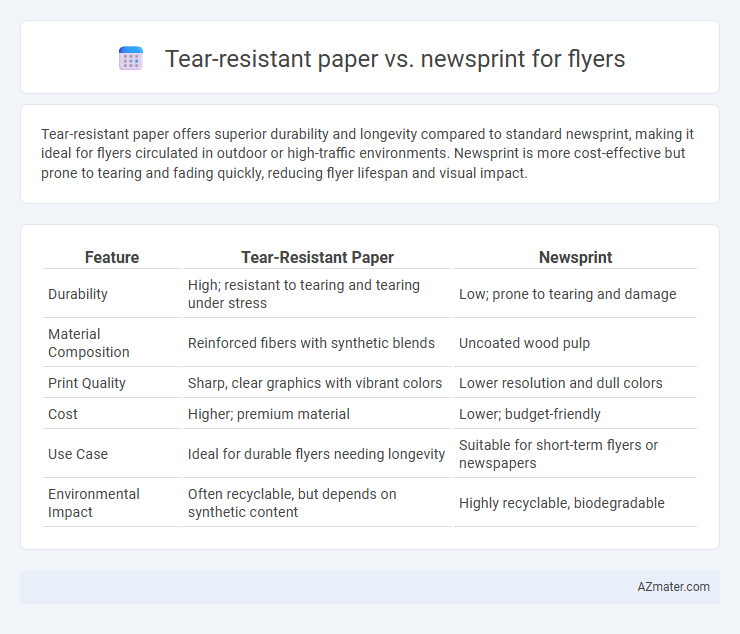Tear-resistant paper offers superior durability and longevity compared to standard newsprint, making it ideal for flyers circulated in outdoor or high-traffic environments. Newsprint is more cost-effective but prone to tearing and fading quickly, reducing flyer lifespan and visual impact.
Table of Comparison
| Feature | Tear-Resistant Paper | Newsprint |
|---|---|---|
| Durability | High; resistant to tearing and tearing under stress | Low; prone to tearing and damage |
| Material Composition | Reinforced fibers with synthetic blends | Uncoated wood pulp |
| Print Quality | Sharp, clear graphics with vibrant colors | Lower resolution and dull colors |
| Cost | Higher; premium material | Lower; budget-friendly |
| Use Case | Ideal for durable flyers needing longevity | Suitable for short-term flyers or newspapers |
| Environmental Impact | Often recyclable, but depends on synthetic content | Highly recyclable, biodegradable |
Introduction to Tear-Resistant Paper and Newsprint
Tear-resistant paper offers enhanced durability, featuring reinforced fibers that prevent easy tearing, making it ideal for flyers requiring longevity and repeated handling. Newsprint, a lightweight, inexpensive paper primarily used for newspapers, is less durable and prone to tearing but remains cost-effective for mass distribution flyers. Choosing between tear-resistant paper and newsprint depends on balancing budget constraints with the desired flyer lifespan and quality.
Defining Flyer Printing Needs
Tear-resistant paper offers enhanced durability and longevity for flyers, especially in outdoor or high-traffic environments where flyers are exposed to handling and weather conditions. Newsprint, a more economical and lightweight option, suits short-term promotions or large-volume distributions where cost efficiency is paramount. Defining flyer printing needs depends on factors like target audience, distribution method, and desired lifespan, guiding the choice between the sturdiness of tear-resistant paper and the affordability of newsprint.
Key Features of Tear-Resistant Paper
Tear-resistant paper offers superior durability with enhanced fiber bonding that prevents easy ripping, making it ideal for flyers that require longevity and repeated handling. Its high tensile strength and resistance to moisture differentiate it significantly from standard newsprint, which tends to tear easily due to its lower density and weak paper pulp composition. This specialized paper also maintains vibrant print quality over time, ensuring that promotional materials remain intact and visually appealing in various environmental conditions.
Properties and Uses of Newsprint
Newsprint is a low-cost, lightweight paper made from wood pulp, characterized by its high porosity and low tensile strength, which makes it less durable compared to tear-resistant paper. It is widely used for newspapers, flyers, and short-term promotional materials due to its affordability and ease of printing, despite being prone to yellowing and tearing over time. Newsprint's absorbent properties allow fast ink drying, making it ideal for large-volume print runs where cost efficiency is prioritized over longevity.
Durability Comparison: Which Lasts Longer?
Tear-resistant paper is designed with enhanced fiber bonding and often includes synthetic additives, making it significantly more durable than traditional newsprint, which is prone to tearing and deterioration when exposed to moisture or rough handling. Newsprint, being thinner and made from lower-grade pulp, tends to degrade quickly, especially in outdoor or high-traffic environments, reducing its lifespan for flyer distribution. For flyer applications requiring longevity and resistance to wear and tear, tear-resistant paper provides a superior option that maintains print quality and structural integrity over extended periods.
Print Quality and Visual Appeal
Tear-resistant paper offers superior print quality with sharper images and vibrant colors compared to newsprint, which often has a duller, lower-resolution appearance. The smooth, coated surface of tear-resistant paper enhances ink absorption and detail, resulting in a more visually appealing flyer that stands out. Newsprint's porous, rough texture can cause ink bleed and faded graphics, making it less ideal for high-impact marketing materials.
Cost Considerations: Tear-Resistant Paper vs Newsprint
Tear-resistant paper typically costs more than newsprint due to its enhanced durability and higher-quality fibers designed to withstand handling and environmental stress. Newsprint remains the most cost-effective option for flyers, favored for large-volume, short-term distribution despite its lower tear resistance and susceptibility to damage. Budget-conscious projects that require longevity and a professional feel often justify the increased investment in tear-resistant paper over the economical but fragile newsprint.
Environmental Impact and Sustainability
Tear-resistant paper offers superior durability, reducing waste by extending the lifespan of flyers compared to newsprint, which is more prone to damage and disposal after brief use. Newsprint is typically made from non-recycled wood fibers and has a higher environmental footprint due to faster degradation and increased deforestation concerns. Choosing tear-resistant paper made from recycled materials supports sustainability through waste reduction and resource conservation in print marketing.
Ideal Applications for Each Paper Type
Tear-resistant paper is ideal for flyers needing durability and longevity, such as outdoor promotions, event handouts, and product instructions, where resistance to tearing and moisture is crucial. Newsprint excels in mass distribution for short-term use, making it perfect for newspapers, flyers in high volume, and budget-conscious advertising campaigns. Choosing tear-resistant paper enhances the flyer's lifespan in challenging environments, while newsprint prioritizes cost-effectiveness and fast turnover.
Choosing the Best Option for Your Flyers
Tear-resistant paper offers enhanced durability and longevity compared to traditional newsprint, making it ideal for flyers that need to withstand frequent handling or outdoor conditions. Newsprint remains a cost-effective choice for short-term, high-volume flyer distribution where budget constraints are significant. Evaluating factors such as flyer lifespan, budget, and usage environment is essential for selecting the best paper type tailored to your promotional needs.

Infographic: Tear-resistant paper vs Newsprint for Flyer
 azmater.com
azmater.com